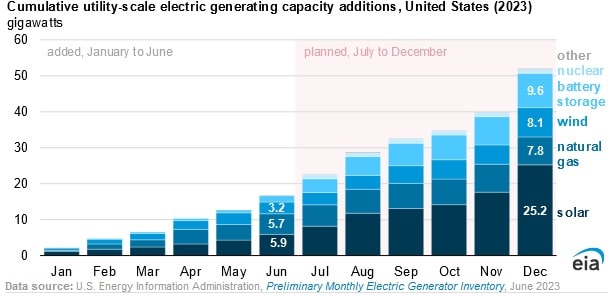Solar to Account for Nearly Two-Thirds of New U.S. Electricity Generating Capacity: EIA

Utility-Scale U.S. solar electricity generation averaged 63.1 gigawatthours between 10am and 6pm each day in the Lower 48 states during August 2024, according to an Oct. 2 report published by the U.S. Energy Information Administration. This is 36 percent higher than for the same hours during 2023.
During August 2024, 107.4 gigawatts (GW) of solar generating electricity capacity was operational in the Lower 48 states compared to 81.9 GW during the same period last year. The increase during August 2024 can be attributed to solar generating capacity surpassing other resources in the U.S. electric power sector during 2023.
The agency projects U.S. utility scale developers to add 24 GW of solar electricity producing capacity between August 2024 and December 2024. During this period, solar is projected to account for nearly two thirds of all new U.S. electricity generating capacity coming into service.
Solar is the fastest-growing renewable source due to larger capacity additions and favorable tax credits policies. In February, the agency projected new solar capacity to increase by 36.4 GW in 2024. If realised, this growth would be almost twice last year’s increase of 18.4 GW, which was a new high for yearly utility-scale solar installation in the country. U.S. solar capacity has risen significantly since 2010, with the exemption of 2022 when solar additions fell by 23 percent year on year in 2022 due to supply chain interruptions and other COVID-19 associated challenges, according to the agency. Texas (35 percent), California (10 percent) and Florida (6 percent) are expected to account for more than half of the new utility-scale solar capacity.
Solar technological advancements are being incentivized by the Biden Administration. Last month, the U.S. Energy Department announced $40 million to bolster solar manufacturing, expand photovoltaic recycling, and foster new markets for solar technologies. The chosen projects will take full advantage of the environmental benefit of solar energy technologies by elevating PV system equipment lifespan and work to enable material retrieval once the equipment is decommissioned. The projects will assist the Biden administration’s attempt to strengthen domestic manufacturing competitiveness and enhance sustainability of solar technologies.
EnerKnol Pulses like this one are powered by the EnerKnol Platform—the first comprehensive database for real-time energy policy tracking. Sign up for a free trial below for access to key regulatory data and deep industry insights across the energy spectrum.
ACCESS FREE TRIAL


